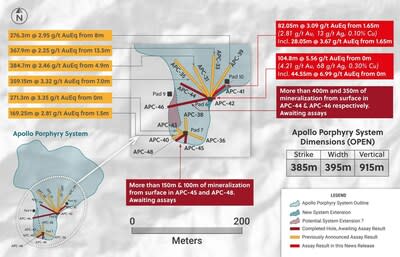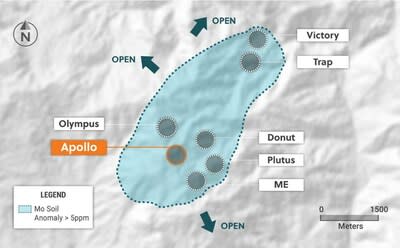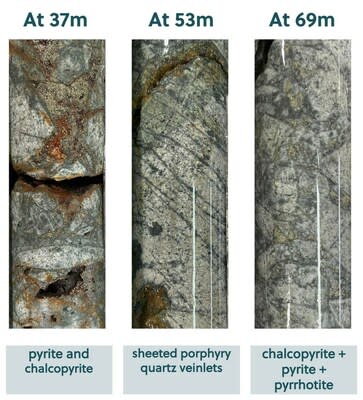- Two reconnaissance holes were drilled eastwards from Pad 6 at the Apollo system to test the potential for high grade mineralization at the eastern contact zone where the inter-mineral breccia and the host porphyry vein stockwork meet. Based on prior observations, the concept to be proved was that the contact zone forms a trap for the accumulation of excess metal driven by the location where the late-stage carbonate base metal veins enter the system. The scout hole, APC-41, was drilled obliquely to the contact and was not optimally situated to fully test the zone. Based on the logging of that hole, APC-42 was then appropriately drilled orthogonal to the contact zone.
- APC-42, which expanded the overall dimensions of the Apollo system modestly to the southwest intersected high-grade gold-silver-copper mineralization from surface over a broad interval with the highest accumulation (grams X metres) of oxide material encountered to date as follows:
- APC-41, which was drilled at a suboptimal angle, also intercepted high-grade mineralization from surface with a robust oxide zone as follows:
- Six additional holes have been completed at the Apollo system with assay results expected in the near term. All six holes intersected cumulative mineralization over varying yet significant downhole drill lengths. Three drill rigs are operating on site with a fourth rig expected to begin operating prior the end of Q2, 2023.
Ari Sussman, Executive Chairman commented: “This new step-out drilling into the eastern area of the Apollo system has outlined a new and important high-grade zone where extensive quartz stockwork veining has resulted in an abundance of high-grade metal being trapped at the interface between breccia and porphyry. A drill hole from Pad 10, located northeast from Pad 6, is underway to test this new high-grade zone along the contact to the northeast. The surprises at Apollo continue to be positive and I am confident that not only will the Apollo porphyry system continue to grow with further exploratory drilling but that we will make new discoveries in the near term by remaining aggressive with our drilling.”
TORONTO, April 25, 2023 /CNW/ – Collective Mining Ltd. (TSXV: CNL) (OTCQX: CNLMF) (“Collective” or the “Company”) is pleased to announce assay results from a further two drill holes completed within the Apollo porphyry system (“Apollo”) at the Guayabales project located in Caldas, Colombia. Apollo is a high-grade, bulk tonnage copper-silver-gold system, which owes its excellent metal endowment to an older copper-silver and gold porphyry system being overprinted by younger precious metal rich, carbonate base metal vein systems (intermediate sulphidation porphyry veins) within a magmatic, hydrothermal inter-mineral breccia body currently measuring 395 metres x 385 metres x 915 metres and open for expansion.
To watch a short video of David Reading, Special Advisor to Collective Mining, speak about the assay results announced today, please click here.
Details (See Table 1 and Figures 1-4)
The Phase II drilling program of 2023 is advancing on schedule with thirteen holes completed and results announced. A further six holes have been drilled and await assay results from the lab. The objectives of the 2023 program is to define the high-grade mineralization and dimensions of the Apollo porphyry system near surface, expand the size of the system through step-out and directional drilling and drill test multiple new targets generated through grassroot exploration. Since the announcement of the discovery hole at Apollo in June 2022, a total of 44 drill holes (approximately 18,400 metres) have been completed and assayed.
This press release announces results from two exploratory holes drilled eastwards from Pad 6 and designed to test the contact zone between the porphyry and inter-mineral breccia. The first hole, APC-41, was drilled to the northeast at a shallow angle and was suboptimal in design as it was drilled oblique to the contact zone. Based on the understanding gained from the first hole, APC-42 was drilled steeply due east and intercepted the contact zone at an orthogonal angle. Assay results and geological observations for both holes are summarized below:
APC-42 was drilled steeply to the east from surface at Pad 6 to a maximum downhole depth of 126.3 metres. The mineralized interval includes 44.55 metres of combined saprolite and saprock with iron oxides formed from the oxidation of the sulphides hosted within the matrix of the breccia and within veins. Below the oxidized zone, the intercept passes into fresh rock with a sulphide composition of 0.5% chalcopyrite, 1.5% pyrite and pyrrhotite (up to 0.5%). One of the characteristic features of this intercept is the fact that it passes through a contact zone between breccia and porphyry. This zone contains both mineralized breccia and a stockwork of sulphide bearing quartz and carbonate veins within the adjacent porphyry material, all of which are associated with intense sericite alteration. Finally, the footwall zone of the porphyry is well altered and hosts mineralization associated with disseminated pyrite and quartz-pyrite veins with assay results as follows:
- 104.8 metres @ 5.56 g/t gold equivalent (consisting of 4.21 g/t gold, 68 g/t silver and 0.3% copper) including:
This intercept is followed by 19.35 metres @ 0.33 g/t gold equivalent from 106.95 metres downhole and is hosted within quartz diorite porphyry.
APC-41 was drilled to the northeast from Pad 6 to a maximum downhole depth of 162.4 metres and was designed to test the contact zone between breccia and porphyry. The mineralized interval starts at 1.65 metres depth below the overburden and intersects 28.05 metres of combined saprolite and saprock with iron oxides formed from the oxidation of the sulphides hosted within the matrix of the breccia and within veins. Below the oxide zone, the intercept passes into fresh rock consisting of quartz diorite breccia with a matrix of chalcopyrite (0.2%), pyrite (up to 2%) and 0.1% pyrrhotite before exiting the breccia and entering into mineralized quartz diorite porphyry. As in APC-42, the contact zone is characterized by a stockwork of sulphide bearing quartz and carbonate, porphyry veins associated with intense sericite alteration. The sericite is overprinting earlier potassium alteration (biotite). Finally, the footwall porphyry is altered and hosts mineralization associated with disseminated pyrite and quartz-pyrite veins with assay results as follows:
- 82.1 metres @ 3.09 g/t gold equivalent (consisting of 2.81 g/t gold, 13 g/t silver and 0.1% copper) including:
This intercept is followed by a lower grade intercept of 57 metres @ 0.34 g/t gold equivalent from 83.7 metres downhole and is hosted within quartz diorite porphyry.
Six additional holes have been completed at the Apollo system with assay results expected in the near term. All holes intersected bulk tonnage mineralization over core length of up to more than 500 metres. APC-45 and APC-48 were shorter holes drilled from Pad 7, designed to test the contact zone between the inter-mineral breccia and porphyry host rock in the southern portion of the deposit. APC-44 and APC-46 were longer holes drilled from Pad 6 as part of the fan pattern of drilling to assess the shallow mineralization in the central area of the system. APC-49 was a deeper hole drilled to the northwest from Pad 6 and APC-47 was drilled eastwards from Pad 4.
The Company presently has three diamond drill rigs operating at the Apollo project with a fourth rig expected to begin operating prior to the end of Q2, 2023. Additional assay results are expected in the near term.
The Apollo target area, as defined to date by surface mapping, rock sampling and copper and molybdenum soil geochemistry, covers a 1,000 metres X 1,200 metres area, and represents a large and unusually high-grade Cu-Ag-Au porphyry system. Mineralizations styles include early-stage porphyry veins, inter-mineral breccia mineralization and multiple zones of porphyry related late stage, sheeted, carbonate-base metal veins with high gold and silver grades. The Apollo target area is still expanding as the Company’s geologists have found multiple additional outcrop areas with porphyry veining, breccia, and late stage, sheeted, carbonate base metal veins.
Table 1: Assay Results
| Hole # | From(am) | To(am) | InterceptInterval (am) | Au(g/t) | Ag(g/t) | Cu% | MO% | Sauté(g/t)* | Cue(%)* | Zone |
| APC-41 | 1.65 | 83.70 | 82.05 | 2.81 | 13 | 0.10 | 0.002 | 3.09 | 1.65 | Interlinearly Breccia |
| Inc** | 1.65 | 29.70 | 28.05 | 3.44 | 15 | 0.07 | 0.001 | 3.67 | Oxidation zone | |
| 83.70 | 140.70 | 57.00 | 0.24 | 3 | 0.34 | Porphyry Host Rock | ||||
| APC-42 | 0.00 | 104.80 | 104.80 | 4.21 | 68 | 0.30 | 0.001 | 5.56 | 2.97 | Interlinearly Breccia |
| Inc** | 0.00 | 44.55 | 44.55 | 6.48 | 37 | 0.10 | 0.001 | 6.99 | Oxidation zone | |
| 84.80 | 104.80 | 20.00 | 6.26 | 24 | 0.10 | 0.002 | 6.59 | Interlinearly Breccia | ||
| APC-42 | 106.95 | 126.30 | 19.35 | 0.26 | 3 | 0.33 | Porphyry Host Rock |
| *Sauté (g/t) is calculated as follows: (Au (g/t) x 0.97) + (Ag g/t x 0.016 x 0.88) + (Cu (%) x 1.87 x 0.90)+ (MO (%)*11.43 x 0.85) and Cue (%) is calculated as follows: (Cu (%) x 0.90) + (Au (g/t) x 0.51 x 0.97) + (Ag (g/t) x 0.009 x 0.88)+ (MO(%)x 6.10 x 0.85) utilizing metal prices of Cu – US$4.10/lb, Ag – $24/oz MO – US$25.00/lb and Au – US$1,500/oz and recovery rates of 97% for Au, 88% for Ag, 85% for MO, and 90% for Cu. Recovery rate assumptions are speculative as limited metallurgical work has been completed to date. A 0.2 g/t Sauté cut-off grade was employed with no more than 15% internal dilution. True widths are unknown, and grades are uncut. |
| (**) Zone of Oxidation |


About Collective Mining Ltd.
To see our latest corporate presentation and related information, please visit www.collectivemining.com
Founded by the team that developed and sold Continental Gold Inc. to Fijian Mining for approximately $2 billion in enterprise value, Collective Mining is a copper, silver, and gold exploration company with projects in Caldas, Colombia. The Company has options to acquire 100% interests in two projects located directly within an established mining camp with ten fully permitted and operating mines.
The Company’s flagship project, Guayabales, is anchored by the Apollo target, which hosts the large-scale, bulk-tonnage and high-grade copper-silver-gold Apollo porphyry system. The Company’s near-term objective is to drill the shallow portion of the porphyry system while continuing to expand the overall dimensions of the system, which remains open in all directions.
Management, insiders and close family and friends own nearly 45% of the outstanding shares of the Company and as a result, are fully aligned with shareholders. The Company is listed on the TSXV under the trading symbol “CNL” and on the OTCQX under the trading symbol “CNLMF”.
Qualified Person (AP) and NI43-101 Disclosure
David Jo Reading is the designated Qualified Person for this news release within the meaning of National Instrument 43-101 (“NI 43-101”) and has reviewed and verified that the technical information contained herein is accurate and approves of the written disclosure of same. Mr. Reading has an MS in Economic Geology and is a Fellow of the Institute of Materials, Minerals and Mining and of the Society of Economic Geology (SE).
Technical Information
Rock, soils and core samples have been prepared and analyzed at SS laboratory facilities in Medallion, Colombia and Lima, Peru. Blanks, duplicates, and certified reference standards are inserted into the sample stream to monitor laboratory performance. Crush rejects and pulps are kept and stored in a secured storage facility for future assay verification. No capping has been applied to sample composites. The Company utilizes a rigorous, industry-standard QUA/AC program.
Information Contact:
Follow Executive Chairman Ari Sussman (@Ariski73) and Collective Mining (@CollectiveMini1) on Twitter.
FORWARD-LOOKING STATEMENTS
This news release contains certain forward-looking statements, including, but not limited to, statements about the drill programs, including timing of results, and Collective’s future and intentions. Wherever possible, words such as “may”, “will”, “should”, “could”, “expect”, “plan”, “intend”, “anticipate”, “believe”, “estimate”, “predict” or “potential” or the negative or other variations of these words, or similar words or phrases, have been used to identify these forward-looking statements. These statements reflect management’s current beliefs and are based on information currently available to management as at the date hereof.
Forward-looking statements involve significant risk, uncertainties, and assumptions. Many factors could cause actual results, performance, or achievements to differ materially from the results discussed or implied in the forward-looking statements. These factors should be considered carefully, and readers should not place undue reliance on the forward-looking statements. Although the forward-looking statements contained in this news release are based upon what management believes to be reasonable assumptions, Collective cannot assure readers that actual results will be consistent with these forward-looking statements. These forward-looking statements are made as of the date of this news release, and Collective assumes no obligation to update or revise them to reflect new events or circumstances, except as required by law.
Neither the TSXV nor its Regulation Services Provider (as that term is defined in the policies of the TSXV) accepts responsibility for the adequacy or accuracy of this news release.
SOURCE Collective Mining Ltd.









